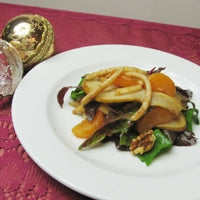Ingredient Challenge: Pears and Tangerines

The holiday season may deck the halls with boughs of holly, but those halls are also filled with buffet tables of waist-expanding temptations that are hard to resist. This month’s featured dish is both healthy and festive with a deliciously rich taste experience that will satisfy that annual need for culinary indulgence, but with very few calories! Jenny Ross, owner and executive chef of the living-foods restaurant 118 Degrees, in Costa Mesa, California, combines her challenge ingredients of pears and tangerines in a tasty dish fit for the celebration season. Chef Jenny’s Tangerine and Pear Holiday Salad is simple to prepare and a reminder of just how good basic fresh fruit and vegetable flavors can be, especially when compared to the array of salty office party snacks, trays of decadent appetizers and holiday sweets that seem to attack from all sides at this time of year.
The Satsuma Mandarin is a hybrid variety, developed in Japan, is available from California citrus orchards in late October through February. The fruit has a delicate flavor that can range from tart to sweet-tart to extremely sweet depending on when it is harvested. Fruit picked early in the season will tend to be a little tart; as the season hits its peak production in December, fruit becomes progressively sweeter. A late season Satsuma can have such a high sugar content that its shelf-life can be shortened considerably; always store this fruit in the refrigerator and use as soon as possible after purchase. However, bring the citrus back up to room temperature before preparation for optimum sugar development. Between the mandarin flavored dressing and the fresh fruit segments, there is a juicy freshness to every bite of this delightful salad!
Note that the words “tangerine” and “mandarin” have both been used referring to the Satsuma in this article. Tangerines are actually a sub-group within the Mandarin family; so all tangerines are mandarins, but not all mandarins are tangerines. Tangerines are usually distinguished by their reddish color, in contrast with the more orange tones found in other members of the mandarin grouping. The mandarin, a native of Southeast Asia, was introduced to the West through the city of Tangiers in Morocco; hence the name “tangerine” and the confusion between mandarins and tangerines in the West.
Chef Jenny leaves the decision of what winter pear to use for this recipe up to individual taste; so I took the opportunity to experiment. So many pears, so little time and each will add a little flavor spin of its own. For the taste test I tried a Bartlett, Bosc and Asian Pear. My choices were actually based on what was ripe at the local retail produce department. Of course, there are many other varietal favorites available for the next several months. Still, my vote goes to the Bosc. The crunchiness of the Asian pear was not as texturally pleasing as the creaminess of the Bosc or Bartlett. I personally think a Bosc has a more complex flavor than the Bartlett. Also, for the “shoe-string” cut, the Bosc held its form much better than the Bartlett, though Asian pear made the best matchstick. Again, to each his (or her) own!
There are also several options for the fresh greens that Jenny suggests in the recipe, namely spinach, red chard or Romaine. I decided to try a combination of spinach and red chard. The chard provided both a heartiness and splash of color appropriate to the season; while the peppery spinach lent a seasoned tang to the dish as well as a nice counter balance to the slightly astringent chard. It was a great combination, thought any one of the chef’s greens recommendations will work as a standalone ingredient just fine. The subtle essence of the Satsuma is also the underpinning ingredient in Chef Jenny’s simply-made, but unforgettable, salad dressing. The rustic earthiness of stone-ground mustard blended with the mandarin juice and olive oil is really the “take home message” of this recipe. Though it pairs perfectly with the rest of the ingredients in Chef Jenny’s salad, I have since used the formula on other salads with great success. In fact, there is fresh batch in my refrigerator right now and I think this versatile dressing is well on its way to becoming my preferred house brand!
Chef Jenny’s 118 Degrees is more than just a restaurant; it is a culinary concept and a multi-pronged web site. Chef Jenny Ross is an author, teacher, dietary counselor and entrepreneur. This recipe attests to this talented chef’s culinary discipline. While the chef’s plating instructions for her Pear & Tangerine Holiday Salad calls for a “starter/tapas sized plate” I must admit to serving myself larger portions with each taste test! I suspect that if you include this on your holiday table, it will garner more “repeat business” than other traditional temptations and without the guilt that comes from seasonal dietary excess. Happy and healthy holidays!
Tangerine and Pear Holiday Salad
Serves 4

Ingredients
For the dressing: (whisk together, can be refrigerated for 5 days)
2 Satsuma Tangerines (juiced & strained)
½ cup Extra Virgin Olive Oil
1 tablespoon Stone-ground Mustard
1 tablespoon Agave Nectar
1 dash Sea Salt
For the Salad
2 medium large size Pears
4 medium Satsuma Tangerines
6 cups Winter Greens (Spinach, Red Chard or Heirloom Romaine)
2 ounces Walnut pieces
2 tablespoon Agave Nectar
1 teaspoon Cinnamon
Preparation
- Slicing one of the pears from top to bottom, create 8⅛ inch thin slices.
- Then slice the remaining pear into matchstick-sized pieces with skin on.
- Place both pear slices and sticks in a large mixing bowl with the agave and cinnamon.
- Toss together until fruit is coated thoroughly and set aside.
- Peel the Satsuma mandarins; separate the segments, removing the white netting.
- Remove the large slices of pear and set aside.
- Add the mandarin segments to the pear stick mixture, tossing to coat thoroughly.
- Clean the greens, remove large stems, slice lengthwise into ½ -inch ribbon-like pieces.
- In a large mixing bowl lightly coat the greens and walnuts with the salad dressing.
- Place 1/2 Cup of the greens mixture in the center of the plate.
- Top with one thin slice of pear laying it horizontally on top of the greens.
- Top the pear sticks and Satsuma mixture.
- Repeat layering one more time.
- Garnish over the top with additional dressing and serve immediately.


Leave a comment